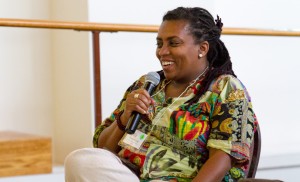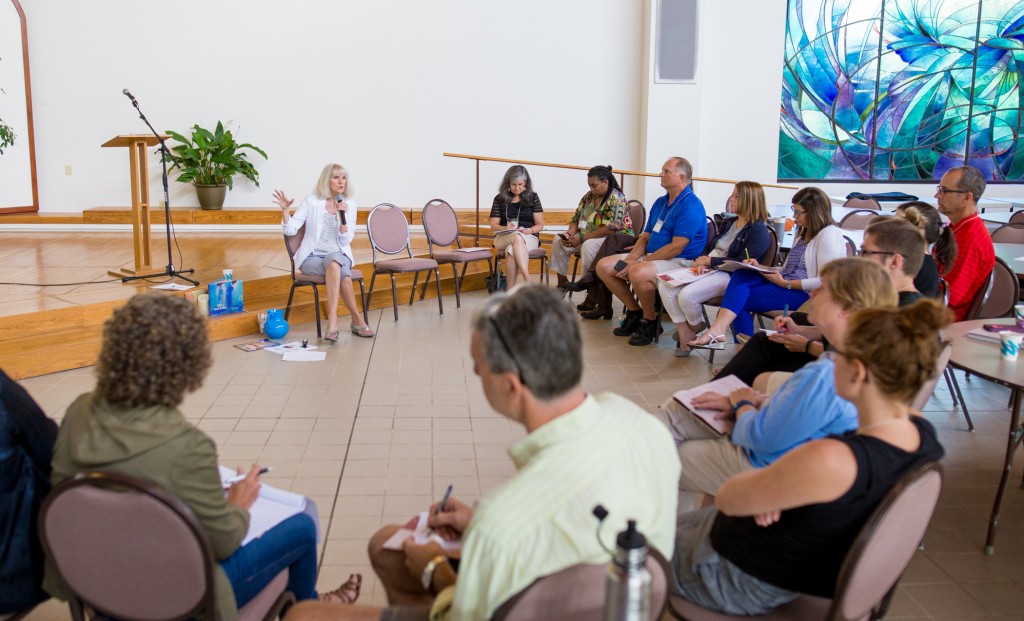Jonathan Stith invoked civil rights leader Ella Baker in his keynote address at Eastern Mennonite University’s Restorative Justice in Education Academy last week. Stith, who is national coordinator at the Alliance for Educational Justice, invoked Baker’s metaphor to speak about restorative justice, educational equity, and the “increasing presence of “black and brown bodies in American classrooms today.”
“It’s not about the hamburger,” he said, referencing her refrain during the 1960’s diner sit-ins. “It’s bigger than a hamburger. We’re not just interested in restorative justice as an alternative to school suspensions and to challenge the school-to-prison pipeline. We are working for more socially just and equitable learning environments for all children and we believe that restorative justice has huge potential to help us get there.”

More than 55 educators from five states, including Mississippi, New Jersey, Pennsylvania, Virginia, Texas and Florida, attended the June 27-28 conference. The range of demographics represent the growing interest in paying attention to educational equity – from public, private and charter schools serving elementary through secondary grade levels with diverse student populations in urban, suburban and rural areas.
RJE benefits manifold
“Our goals for this experience were to ask two big questions,” said Sarah Armstrong, director of the graduate education program at EMU and a former superintendent, principal and teacher. “We wanted to discuss how RJE can assist us in addressing the needs of disenfranchised students and students on the fringe, and the challenges of poor attendance, graduation rates, low achievement and discipline concerns. Secondly, we wanted to share how RJE can benefit students, teachers and the overall school culture.”
Professor Kathy Evans, lead faculty in EMU’s new MA in Restorative Justice in Education program (starting fall 2018), was pleased with the diverse group and the conference’s potential to spread the ethos of restorative justice. [To read more about Kathy Evans and her interview in The Atlantic about restorative justice, click here.]
“I’m thrilled that we have so many people here from different places and sectors who are interested in learning more about restorative justice is a viable option for restoring healthy learning communities,” she said. “Attending this conference doesn’t make anyone an expert, but we hope it will prompt educators to continue their learning. This is about a long-term shift in the way that we do school.”
EMU deeply rooted in origins of restorative justice
Restorative justice, known as RJ for short, presents an alternative philosophy of justice that addresses the needs of multiple stakeholders, draws from indigenous and faith-based approaches, and challenges structural and interpersonal forms of harm. It’s used in a variety of settings, such as prisons and the justice system. RJ in education, which is also called RJE, has been used successfully in school districts to lower suspension rates and to create accountability and community in the schooling environment.
The principles and practices of RJ are strongly rooted at EMU, which is the academic home of Professor Howard Zehr, widely considered the “grandfather” of restorative justice.
Learning and Reflecting Time
The RJE Academy rotated educators through three foundational workshops about RJ principles and practices, such as the circle process, and peacebuilding.

In her session on RJ principles, Evans touched on building healthy communities, meeting needs, viewing conflict as a learning opportunity, and providing accountability.
“If my rosebush isn’t growing, I don’t blame the rosebush,” she said. “We have to look at the ecological or environmental model… Students behave in certain ways depending on unmet needs. Can we meet some of those needs using restorative justice?”
The peacebuilding session focused in part on building relationships, or “tending, mending and befriending,” as Professor Judy Mullet suggested.
Participants also reflected on how their learnings could be applied in their particular setting and heard from educators currently building or creating RJ-oriented models in their particular schools.
“RJE is about a way of approaching life and relationships,” says David Ward, student assistance counselor at Harrisonburg High School. Ward says RJE principles were helpful in adapting anti-bullying curriculum to meet school-specific needs, such as community building and establishing common ground between different student groups.
Other panelists included Aundrea Smiley, a second-grade teacher in Waynesboro City Schools; Allison Eanes, a middle school teacher from Harrisonburg City Schools; Jennifer Morris, principal at Shelburne Middle School in Staunton; and Jelisa Wolfe, executive director of student services for Staunton City Schools.
A final session offered small-group coaching with session leaders.
Harrisonburg educators implementing RJ

Armstrong and Evans both noted they were especially pleased with presence of the 17 Harrisonburg City Schools educators.
“This ongoing opportunity to partner with our local school district to raise our levels of knowledge and practice locally is really thrilling,” said Evans, who is also working on a W.K. Kellogg Foundation grant with Jackson Public Schools, an area where she has strong ties. “We can really do mutually beneficial work on a local level as partners in moving RJ forward.”
The academy’s format was created, among other purposes, “with the potential to take to any school district in the nation,” Evans says.
